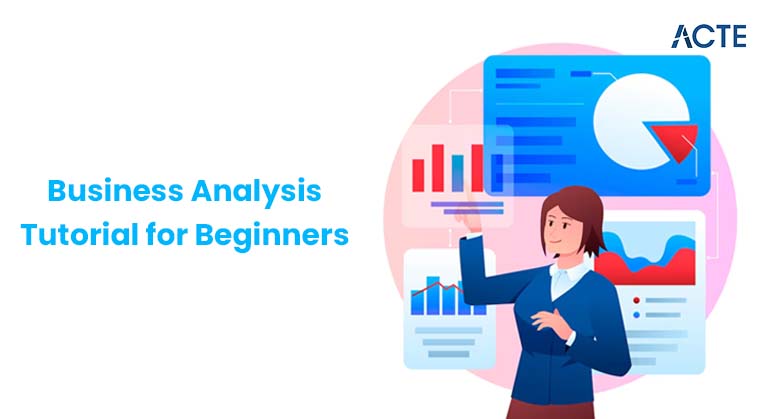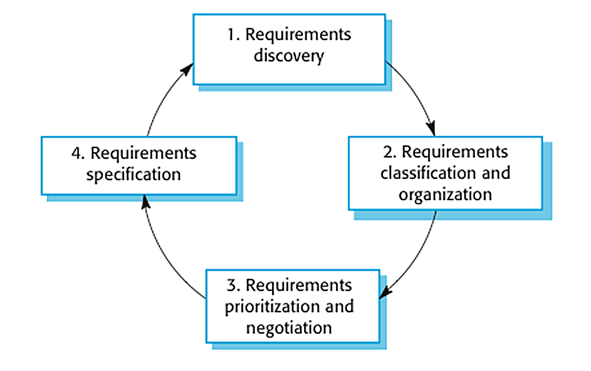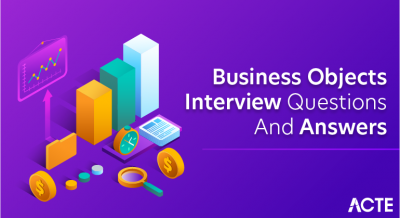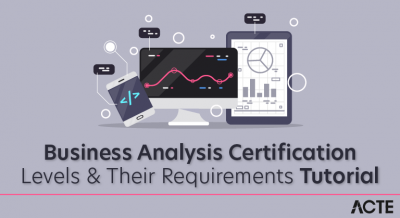
- Introduction to Business Analysis
- Who is a Business Analyst?
- Key Concepts and Definitions
- Life Cycle of Business Analysis
- Requirement Elicitation
- Documentation and Modeling
- BA Tools Overview
- Business Analysis Certifications
Introduction to Business Analysis
Business Analysis is a crucial discipline that bridges the gap between business needs and technological solutions, enabling organizations to achieve their goals efficiently and effectively. It involves identifying business problems, analyzing processes, gathering requirements, and recommending solutions that deliver value to stakeholders. Business Analyst Training equips professionals with the necessary skills to effectively perform these tasks and ensure alignment with business goals. Whether you are new to the field or looking to enhance your skills, understanding the fundamentals of Business Analysis is essential in today’s fast-paced, data-driven environment. This Business Analysis Tutorial provides a comprehensive introduction to the key concepts, tools, and techniques used by business analysts across various industries. From stakeholder management and requirement elicitation to modeling and solution assessment, this guide covers the foundational knowledge needed to thrive in the role. A solid grasp of Business Analysis empowers professionals to make informed decisions, improve business processes, and ensure successful project outcomes. As organizations increasingly rely on data and digital transformation, the demand for skilled business analysts continues to grow. This tutorial serves as a starting point for aspiring analysts and a refresher for seasoned professionals, offering practical insights and real-world examples to build your competence and confidence. Dive into this Business Analysis Tutorial to unlock your potential and contribute meaningfully to business success.
Are You Interested in Learning More About Web Developer Certification? Sign Up For Our Business Analyst Online Training Today!
Who is a Business Analyst?
- Requirement Gathering: Engages with stakeholders to understand their needs and gather detailed business and technical requirements.
- Process Analysis: Analyzes existing business processes, identifies gaps or inefficiencies, and recommends improvements to optimize performance. Understanding the differences between Product Owner vs Business Analyst roles is essential in ensuring that both positions work together effectively to drive business value and streamline processes for optimal outcomes.
- Documentation: Prepares clear and structured documents such as Business Requirement Documents (BRDs), Functional Requirement Documents (FRDs), and use cases.
A Business Analyst is a professional who acts as a bridge between business stakeholders and IT teams, helping organizations identify their needs, analyze problems, and deliver data-driven solutions that improve efficiency and performance. They play a critical role throughout the Life Cycle of Business Analysis, ensuring that every stage, from requirement gathering to implementation, is aligned with business objectives. Understanding who a Business Analyst is and what they do is essential for anyone exploring the field through a Business Analysis Tutorial.
Here are six key roles and responsibilities of a Business Analyst:

- Communication Bridge: Acts as a liaison between business users and technical teams, ensuring clear communication and shared understanding.
- Use of Business Analyst Tools and Techniques: Utilizes tools like SWOT analysis, BPMN, flowcharts, and software such as JIRA, MS Visio, or Trello to streamline analysis and project management.
- Support Through the Life Cycle of Business Analysis: Provides ongoing support through all phases, from planning and analysis to testing and deployment, ensuring project goals are met.
- Enterprise Analysis: Identifying business opportunities, assessing current capabilities, and defining the scope of improvement initiatives.
- Requirement Planning and Management: Establishing how requirements will be gathered, tracked, and managed throughout the project lifecycle.
- Requirement Elicitation: Using Business Analysis Techniques for success, such as interviews, workshops, and surveys, helps gather detailed business needs from stakeholders. These techniques ensure that the requirements are accurately captured, enabling the creation of solutions that align with business goals and deliver value.
- Requirement Analysis and Documentation: Analyzing, prioritizing, and documenting requirements using models, diagrams, and structured templates.
- Solution Assessment and Validation: Evaluating proposed solutions, ensuring they meet business needs, and validating them through testing and stakeholder feedback.
- Implementation and Support: Supporting the rollout of the solution, managing changes, and measuring outcomes to ensure long-term success.
- Requirement Documentation: Capturing business requirements in structured formats such as Business Requirement Documents (BRDs) and Functional Requirement Documents (FRDs) to provide a clear reference point for stakeholders.
- Use Case Diagrams: Visual representations that outline how users interact with a system, highlighting user requirements and expected system behavior.
- Process Flow Diagrams: Diagrams that illustrate the flow of activities, decisions, and data across processes, helping to identify inefficiencies and areas for improvement. Additionally, exploring Business Intelligence Is The Best Career Option can enhance your ability to leverage data-driven insights, making you a key player in improving business processes and driving organizational success.
- Data Modeling: Creating models like Entity-Relationship Diagrams (ERDs) to represent data structures, relationships, and how data flows within the system.
- Prototypes and Wireframes: Developing mock-ups or low-fidelity prototypes to demonstrate how the final system or product will function, offering stakeholders a visual preview.
- Traceability Matrix: A tool used to track the relationship between requirements and project deliverables, ensuring that all requirements are met throughout the project lifecycle.
A well-structured Business Analysis Tutorial can help aspiring professionals master these skills and become successful Business Analysts.
Key Concepts and Definitions
Understanding the key concepts and definitions in Business Analysis is essential for anyone aiming to navigate the field effectively. At its core, Business Analysis focuses on identifying business needs, solving problems, and delivering value through solutions that align with organizational goals. One of the foundational aspects is Requirement Elicitation, which involves gathering and clarifying the needs of stakeholders through interviews, workshops, surveys, and observations. Various Requirement Elicitation Techniques help ensure accuracy and completeness in capturing these needs. Understanding What is Ordinal Data can also be important in the analysis phase, as it allows analysts to categorize and prioritize requirements based on a specific order, adding clarity to the process and improving decision-making. Once requirements are collected, the next step involves Documentation and Modeling, where business analysts create structured documents and visual models such as process flows, use cases, and data diagrams to communicate requirements and solutions. To enhance productivity and accuracy, professionals rely on various Business Analysis Tools, including platforms like JIRA, MS Visio, and Lucidchart, which aid in tracking, modeling, and collaboration. For those looking to validate and advance their skills, pursuing Business Analysis Certifications such as CBAP, CCBA, or PMI-PBA is a recognized path to demonstrate expertise and credibility. Mastering these core elements not only builds a strong foundation in business analysis but also prepares professionals to contribute effectively to project success and business growth.
Are You Preparing for Business Analyst Jobs? Check Out ACTE’s Business Analyst Interview Questions & Answers to Boost Your Preparation!
Life Cycle of Business Analysis
The Life Cycle of Business Analysis represents the structured process that business analysts follow to identify business needs, develop solutions, and ensure successful implementation. Understanding each phase of this cycle is essential for delivering value-driven outcomes. Whether you’re a beginner or a professional revisiting core concepts, a well-structured Business Analysis Tutorial can help you navigate this cycle effectively using the right Business Analysis Tools and Techniques.
Here are the six key phases in the Life Cycle of Business Analysis:
Each phase in the Life Cycle of Business Analysis is supported by specialized Business Analyst Tools and Techniques, making the process both effective and adaptable across industries.
Are You Considering Pursuing a Master’s Degree in Business Analyst? Enroll For Business Analyst Masters Program Training course Today!
Requirement Elicitation
Requirement Elicitation is a critical phase in the business analysis process, focused on gathering accurate and comprehensive information from stakeholders to understand their needs, expectations, and constraints. It serves as the foundation for building effective solutions that align with business objectives. Business Analyst Training equips professionals with a variety of Requirement Elicitation Techniques, including interviews, workshops, brainstorming sessions, document analysis, surveys, and observation, to uncover both stated and hidden requirements. This training helps analysts effectively gather and analyze information to ensure the successful delivery of business solutions. Selecting the right approach often depends on the project’s complexity, stakeholder availability, and organizational environment. To support this process, professionals rely on various Business Analysis Tools such as JIRA, Confluence, MS Visio, and Lucidchart, which help in organizing information, visualizing requirements, and fostering collaboration. Once elicited, the requirements must be captured through Documentation and Modeling, using tools like use case diagrams, flowcharts, and data models to ensure stakeholders and technical teams have a shared understanding. Mastery in Requirement Elicitation is essential for minimizing risks, avoiding costly rework, and ensuring successful project delivery. For those looking to enhance their expertise, pursuing Business Analysis Certifications like CBAP or PMI-PBA can provide formal training in elicitation strategies and tools, reinforcing the importance of this core skill in the overall business analysis lifecycle.

Documentation and Modeling
Documentation and Modeling are essential aspects of business analysis that help transform collected requirements into clear, actionable plans. These processes ensure that all stakeholders have a shared understanding of the business needs, requirements, and proposed solutions. Proper documentation provides a reference for future stages of the project, while effective modeling offers visual representations that simplify complex information. Here are the key components involved in Documentation and Modeling:
Incorporating effective Documentation and Modeling techniques ensures clarity, alignment, and smooth communication throughout the project, significantly increasing the likelihood of project success.
BA Tools Overview
BA Tools Overview provides a comprehensive look into the tools and software used by business analysts to facilitate various stages of the business analysis process. These tools play a vital role in activities like Requirement Elicitation, Documentation and Modeling, and stakeholder communication, ensuring that the project aligns with business objectives and is executed efficiently. Business Analysis Tools such as JIRA, Microsoft Visio, Lucidchart, and Balsamiq help analysts collect, visualize, and manage requirements and workflows. Exploring Power BI Desktop can further enhance your analytical capabilities, allowing you to transform complex data into actionable insights and better support decision-making throughout the analysis process. During the Requirement Elicitation phase, tools enable analysts to organize data gathered through Requirement Elicitation Techniques like interviews, surveys, and workshops, making it easier to document and share information. In Documentation and Modeling, these tools help analysts create detailed reports, process flow diagrams, and data models that communicate the scope, requirements, and processes. Moreover, leveraging these tools enhances collaboration among cross-functional teams, reducing errors and improving decision-making. For business analysts looking to deepen their expertise, earning Business Analysis Certifications such as CBAP, PMI-PBA, or CCBA can provide valuable insights into the best practices and methodologies for using these tools effectively. Ultimately, the right Business Analysis Tools can streamline the entire analysis process, ensuring smoother project execution and better outcomes.
Business Analysis Certifications
Business Analysis Certifications are an excellent way for professionals to validate their skills and expertise in the field of business analysis. These certifications offer structured learning paths and are recognized globally, enhancing career opportunities and credibility. Pursuing certifications such as CBAP (Certified Business Analysis Professional), PMI-PBA (Professional in Business Analysis), or CCBA (Certification of Competency in Business Analysis) can provide in-depth knowledge of the Life Cycle of Business Analysis, helping individuals gain proficiency in each stage of the process, from requirement gathering to solution implementation. A Business Analyst Training tutorial is often the first step in preparing for these certifications, as it introduces foundational concepts, tools, and techniques used throughout the analysis process. This training provides the necessary knowledge to build a strong foundation in business analysis, enabling professionals to excel in their roles. The certifications also focus on Business Analyst Tools and Techniques, equipping professionals with the skills to effectively use software tools and methodologies like flowcharts, BPMN, SWOT analysis, and requirement management platforms. These certifications are designed to ensure that business analysts are equipped to handle real-world challenges and add value to any organization. Whether you’re new to the field or an experienced analyst, obtaining a certification can elevate your career by demonstrating your commitment to continuous learning and your ability to contribute strategically to business success.




